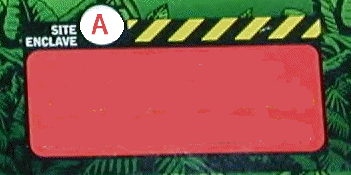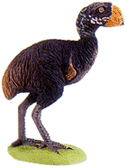 The age of mammals starts with the
Paleocene and Eocene Epochs. These Early Mammals begin to fill the niches left by the dinosaurs. After larger
terrestrial animals had become extinct at the end of the Cretaceous, pantodonts,
uintatheres and xenungulates were the first mammals to evolve to larger size.
All were originally put in the order Amblypoda (meaning "blunt foot or slow
foot"), but are currently put in the separate orders Pantodonta, Dinocerata and Xenungulata.
Diatryma the original big bird. The most notable feature was its large,
parrot-like beak. Some paleontologists believe that this large, sharp beak
indicate that Diatryma was the dominant predator of the northern continents.
Gastornis is another genus of extinct birds; found in France, it may either be a
close relative of Diatryma, or may be the same animal, but its fossils are too
rare to determine which. Gastornis has a lead role in the Walking with
Prehistoric Beast documentary so it may start showing up in toy lines.
Diatryma was part of the MPC series of Prehistoric animals and Barylamba was
part of the Nabisco/Lido premiums. Eobasileus and it relatives have shown up in
mammal sets from Starlux, Play Vision and JA-RU. Andrewsarchus is another
popular early mammal made by Starlux, Play Vision and the Kaiyodo Dino Tales. There
always seems to be rhino type animal every epoch. Brontotheres were a
rhinoceros analogue. They get a cameo in the animated movie Ice Age.
Although they were long gone by the time the show was set in.
The age of mammals starts with the
Paleocene and Eocene Epochs. These Early Mammals begin to fill the niches left by the dinosaurs. After larger
terrestrial animals had become extinct at the end of the Cretaceous, pantodonts,
uintatheres and xenungulates were the first mammals to evolve to larger size.
All were originally put in the order Amblypoda (meaning "blunt foot or slow
foot"), but are currently put in the separate orders Pantodonta, Dinocerata and Xenungulata.
Diatryma the original big bird. The most notable feature was its large,
parrot-like beak. Some paleontologists believe that this large, sharp beak
indicate that Diatryma was the dominant predator of the northern continents.
Gastornis is another genus of extinct birds; found in France, it may either be a
close relative of Diatryma, or may be the same animal, but its fossils are too
rare to determine which. Gastornis has a lead role in the Walking with
Prehistoric Beast documentary so it may start showing up in toy lines.
Diatryma was part of the MPC series of Prehistoric animals and Barylamba was
part of the Nabisco/Lido premiums. Eobasileus and it relatives have shown up in
mammal sets from Starlux, Play Vision and JA-RU. Andrewsarchus is another
popular early mammal made by Starlux, Play Vision and the Kaiyodo Dino Tales. There
always seems to be rhino type animal every epoch. Brontotheres were a
rhinoceros analogue. They get a cameo in the animated movie Ice Age.
Although they were long gone by the time the show was set in. 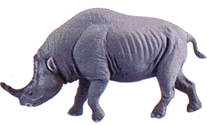
The world begins to dry up. Antarctica begins to freeze over and grass
transforms the world and the animals in it. In Oligocene we get grass for the first time. Modern families of mammals develop in the following Miocene and Pliocene. Animals that look like horses, camels and modern cats start to show up.
This period has only attracted toy makers Bullyland and Starlux from Europe. 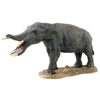 High quality figures in resin are much more common such as the Salas line of
prehistoric mammals. Chalicotheres,
Indricotheres and Hyenadonts show up in Walking with Prehistoric Beasts and we
can expect that will generate some interest in new toy figures. The
Miocene was a time of warmer global climates than those in the preceding
Oligocene, or the following Pliocene. Grasslands become an important ecological
zone. The Pliocene is marked by cooler climates and the land bridge between the
Americas appears allowing exchange of fauna and the grasslands expand further.
This is the last of what in retrospect must have been an Eden like existence
before the coming of the ice.
High quality figures in resin are much more common such as the Salas line of
prehistoric mammals. Chalicotheres,
Indricotheres and Hyenadonts show up in Walking with Prehistoric Beasts and we
can expect that will generate some interest in new toy figures. The
Miocene was a time of warmer global climates than those in the preceding
Oligocene, or the following Pliocene. Grasslands become an important ecological
zone. The Pliocene is marked by cooler climates and the land bridge between the
Americas appears allowing exchange of fauna and the grasslands expand further.
This is the last of what in retrospect must have been an Eden like existence
before the coming of the ice.
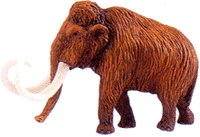 In
the Pleistocene the Ice Ages shape
evolution. Mammoths and their cousins the mastodons,
long horned bison,
saber toothed cats, giant ground sloth's, and many other large mammals
characterized Pleistocene habitats in North America, South America, Asia, and Europe. In Europe Homo erectus and the Neanderthals rule for 70,000 years. Native
horses and camels galloped across the plains of North America. The tundra of North America was much more diverse than today but the common modern animals were present. Great teratorn
birds with 25-foot wingspans stalked prey. Around the end of the Pleistocene,
all these creatures went extinct. Interest in Prehistoric Mammals has
been generated by Discovery Channels Walking with Prehistoric Beasts, Ice Age and Raising
the Mammoth movies and documentaries. Mammoths, Mastodons, Smilodon, the Sloth and the Woolly
Rhino show up in Classic toy sets in the 50's and 60's from Marx and Miller.
Nabisco and MPC expanded the range of figures most of which still look pretty
good. The major difference is modern figures tend to be painted.
Most major lines will include Smilodon and the Woolly Mammoth if no other mammal
figures. European toy companies tend to show more interest in Prehistoric
Mammals than American or Asian companies.
In
the Pleistocene the Ice Ages shape
evolution. Mammoths and their cousins the mastodons,
long horned bison,
saber toothed cats, giant ground sloth's, and many other large mammals
characterized Pleistocene habitats in North America, South America, Asia, and Europe. In Europe Homo erectus and the Neanderthals rule for 70,000 years. Native
horses and camels galloped across the plains of North America. The tundra of North America was much more diverse than today but the common modern animals were present. Great teratorn
birds with 25-foot wingspans stalked prey. Around the end of the Pleistocene,
all these creatures went extinct. Interest in Prehistoric Mammals has
been generated by Discovery Channels Walking with Prehistoric Beasts, Ice Age and Raising
the Mammoth movies and documentaries. Mammoths, Mastodons, Smilodon, the Sloth and the Woolly
Rhino show up in Classic toy sets in the 50's and 60's from Marx and Miller.
Nabisco and MPC expanded the range of figures most of which still look pretty
good. The major difference is modern figures tend to be painted.
Most major lines will include Smilodon and the Woolly Mammoth if no other mammal
figures. European toy companies tend to show more interest in Prehistoric
Mammals than American or Asian companies.
